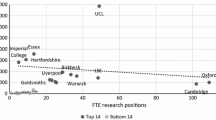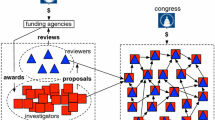Abstract
The tension between equity and excellence is fundamental in science policy. This tension might appear to be resolved through the use of merit-based evaluation as a criterion for research funding. This is not the case. Merit-based decision making alone is insufficient because of inequality aversion, a fundamental tendency of people to avoid extremely unequal distributions. The distribution of performance in science is extremely unequal, and no decision maker with the power to establish a distribution of public money would dare to match the level of inequality in research performance. We argue that decision makers who increase concentration of resources because they accept that research resources should be distributed according to merit probably implement less inequality than would be justified by differences in research performance. Here we show that the consequences are likely to be suppression of incentives for the very best scientists. The consequences for the performance of a national research system may be substantial. Decision makers are unaware of the issue, as they operate with distributional assumptions of normality that guide our everyday intuitions.



Similar content being viewed by others
Notes
The Gini coefficient is a measure of inequality that ranges between 0 and 1 with 0 representing perfect equality where everyone has the same resources and 1 representing perfect inequality where one person has all the income while everyone else has zero income. The Gini coefficient was originally based on the average of the absolute differences between all pairs of incomes in the distribution and defined to be the ratio of half of that average to the mean of the distribution (Dorfman, 1979). Today the Gini coefficient is commonly explained in geometric terms using Lorenz curves. For any income distribution, the Lorenz curve is constructed from data ordered ascending by share of resources. It plots the cumulative share of income against the cumulative share of population. If everyone had the same income, the curve would be a straight line at a 45 degree angle. This line is plotted on graphs of Lorenz curves and is called the “line of equality.” If one person had all the income, the curve would be a vertical line at 100% of the population. The Gini coefficient is a ratio between two areas: 1) the area between the line of equality and the Lorenz curve and 2) the total area under the line of equality.
The equations for the power law is p(x) = Cx-n for x> xmin
Gini coefficients calculated using Wessa, P. (2008), Free Statistics Software, Office for Research Development and Education, version 1.1.22-r4, URL http://www.wessa.net/
Gini coefficient calculated by translating grades onto a 1 through 7 scale.
Between 2003 and 2007, the weighting given to grade 4 did not change. Grade 5 gained 14% and Grade 5* gained 30%. In addition, in 2003 a pool of money was made available to departments that had attained 5* in both the 2001 and 1996 RAE exercises. This money further accentuates the slide and is referred to as the “super 5* premium” in the table. The exact effect is not known here but is suggested by an arrow and a question mark in the graph.
The empirical, non-stylized story is more complex. During this period the inequality in the funding distributed decreased because other elements in the final distribution formula were unrelated to research performance. In 2007, HEFCE commented that the increase in inequality seen here was meant to counterbalance these other elements in the formula that were not quality weighted: “There has been a modest increase in the steepness of the selectivity scale within mainstream QR, to counterbalance the fact that RDP supervision and QR charity support funds are not quality weighted, other than for the threshold criterion that activity must be in departments rated 4 or above.” From letter to Vice-chancellor Exeter from HEFCE in 2007, admin.exeter.ac.uk/ppr/GrantLetterMarch07_0119.doc.
Not salary increases, but rather grant funding to buy equipment and hire students and post-docs and pay summer salary.
Bement also expects the pursuit of transformative research to be high risk. There is overlap in the formal analysis of risk and inequality, therefore it is not a surprise that when people discuss something distributed so unequally as is research output and impact, that they regularly note the unaccustomed level of risk involved.
Personal communication, Juan Rogers, January 2008, based on interviews with researchers responsible for key discoveries in nanotechnology.
References
Amiel, Yoram, and Frank Cowell. 1999. Thinking about Inequality. Cambridge: Cambridge University Press.
Bement, Arden L. Jr. 2007. Transformative Research: The Artistry and Alchemy of the 21st Century, speech given at the Texas Academy of Medicine, Engineering and Science Fourth Annual Conference, Austin, Texas, January 4, 2007, available at: http://www.nsf.gov/news/speeches/bement/07/alb070104_texas.jsp, downloaded on January 11, 2008.
Clauset, Aaron, Cosma Rohilla Shalizi and M.E.J. Newman. 2009. Power-Law Distributions in Empirical Data. SIAM Review 51: 661–703. (Preprint at arxiv:0706.1062).
Dawes, Christopher T., James H. Fowler, Tim Johnson, Richard McElreath and Oleg Smirnov. 2007. Egalitarian motives in humans. Nature 446: 794-796.
Dorfman, Robert. 1979. A Formula for the Gini Coefficient. The Review of Economics and Statistics 61: 146-149.
Engelmann, Dirk, and Martin Strobel. 2004. Inequality Aversion, Efficiency, and Maximin Preferences in Simple Distribution Experiments. The American Economic Review 94: 857-869.
Feller, Irwin. 2001. Elite and/or Distributed Science. Chapter 9 in Maryann P. Feldman and Albert N. Link (eds.) Innovation Policy in the Knowledge-Based Economy. Dordrecht, The Netherlands: Kluwer Academic.
Gläser, Jochen, Grit Laudel, Sybille Hinze and Linda Butler. 2002. Impact of evaluation-based funding on the production of scientific knowledge: What to worry about and how to find out. Expertise for the German Ministry for Education and Research, May, http://repp.anu.edu.au/expertise-glae-lau-hin-but.pdf.
Geuna, Aldo. 1998. Resource Allocation and Knowledge Production: Studies in the Economics of University Research. Dissertation no. 98-41, Faculty of economics and Business Administration Universiteit Maastricht, The Netherlands.
Hand, Eric. 2008. Day in the Life of an 11 Grant Grandee. Nature 452: 259.
HEFCE 2002. Funding higher education in England: How the HEFCE allocates its funds. HEFCE 02/18, http://www.hefce.ac.uk/pubs/hefce/2002/02_18/02_18contents.pdf.
HEFCE 2003. Funding higher education in England: How the HEFCE allocates its funds. HEFCE 03/29, http://www.hefce.ac.uk/pubs/hefce/2003/03_29/03_29.pdf.
HEFCE 2007a. Funding higher education in England: How the HEFCE allocates its funds. HEFCE 07/20, http://www.hefce.ac.uk/Pubs/hefce/2007/07_20/07_20.pdf.
HEFCE 2007b. Funding data for quality-related research QR. funding: 2007-08 Quality-related research funding. http://www.hefce.ac.uk/research/funding/qrfunding/, data as at March 1, 2007.
Lotka, Alfred J. 1926. The Frequency Distribution of Scientific Productivity. Journal of the Washington Academy of Sciences 16: 317-323.
Morin, Alexander J. 1993. Science Policy and Politics. Upper Saddle River, NJ: Prentice-Hall.
Tricomi, Elizabeth, Antonio Rangel, Colin F. Camerer and John P. O’Doherty. 2010. Neural evidence for inequality-averse social preferences. Nature 463: 1089-1091.
Wu, Yonghong. 2010. Tackling undue concentration of federal research funding: An empirical assessment on NSF’s Experimental Program to Stimulate Competitive Research (EPSCoR), Research Policy 39: 835-841.
Acknowledgements
The authors would like to thank the many colleagues whose valuable comments helped shape this paper, including Christian Houdre, Juan Rogers, Doug Noonan, John Walsh, and participants in a seminar at University of Twente.
Author information
Authors and Affiliations
Corresponding author
Rights and permissions
About this article
Cite this article
Hicks, D., Katz, J.S. Equity and Excellence in Research Funding. Minerva 49, 137–151 (2011). https://doi.org/10.1007/s11024-011-9170-6
Published:
Issue Date:
DOI: https://doi.org/10.1007/s11024-011-9170-6




